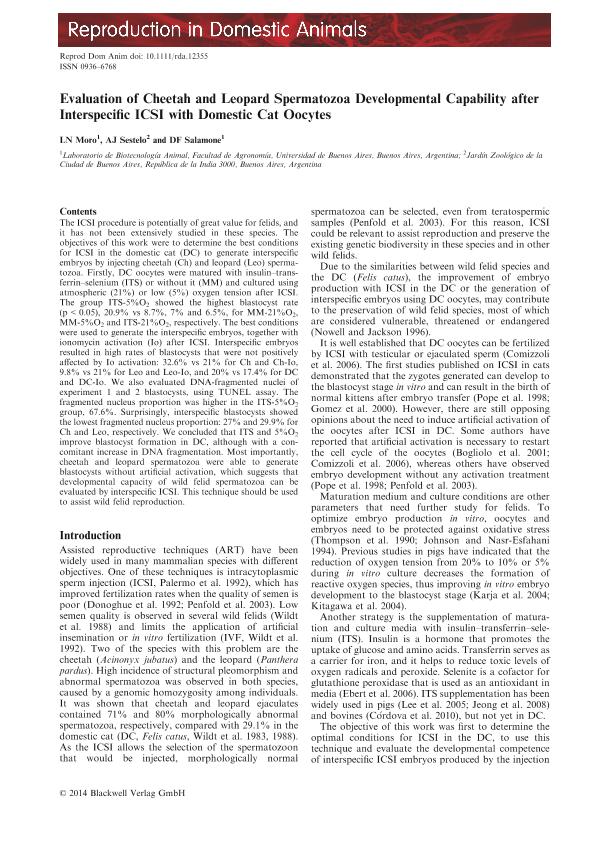Mostrar el registro sencillo del ítem
dc.contributor.author
Moro, Lucía Natalia

dc.contributor.author
Sestelo, A. J.
dc.contributor.author
Salamone, Daniel Felipe

dc.date.available
2017-05-10T18:06:17Z
dc.date.issued
2014-08
dc.identifier.citation
Moro, Lucía Natalia; Sestelo, A. J.; Salamone, Daniel Felipe; Evaluation of Cheetah and Leopard Spermatozoa Developmental Capability after Interspecific ICSI with Domestic Cat Oocytes; Wiley Blackwell Publishing, Inc; Reproduction In Domestic Animals; 49; 4; 8-2014; 693-700
dc.identifier.issn
0936-6768
dc.identifier.uri
http://hdl.handle.net/11336/16223
dc.description.abstract
The ICSI procedure is potentially of great value for felids, and it has not been extensively studied in these species. The objectives of this work were to determine the best conditions for ICSI in the domestic cat (DC) to generate interspecific embryos by injecting cheetah (Ch) and leopard (Leo) spermatozoa. Firstly, DC oocytes were matured with insulin–transferrin–selenium (ITS) or without it (MM) and cultured using atmospheric (21%) or low (5%) oxygen tension after ICSI. The group ITS-5%O2 showed the highest blastocyst rate (p < 0.05), 20.9% vs 8.7%, 7% and 6.5%, for MM-21%O2, MM-5%O2 and ITS-21%O2, respectively. The best conditions were used to generate the interspecific embryos, together with ionomycin activation (Io) after ICSI. Interspecific embryos resulted in high rates of blastocysts that were not positively affected by Io activation: 32.6% vs 21% for Ch and Ch-Io, 9.8% vs 21% for Leo and Leo-Io, and 20% vs 17.4% for DC and DC-Io. We also evaluated DNA-fragmented nuclei of experiment 1 and 2 blastocysts, using TUNEL assay. The fragmented nucleus proportion was higher in the ITS-5%O2 group, 67.6%. Surprisingly, interspecific blastocysts showed the lowest fragmented nucleus proportion: 27% and 29.9% for Ch and Leo, respectively. We concluded that ITS and 5%O2 improve blastocyst formation in DC, although with a concomitant increase in DNA fragmentation. Most importantly, cheetah and leopard spermatozoa were able to generate blastocysts without artificial activation, which suggests that developmental capacity of wild felid spermatozoa can be evaluated by interspecific ICSI. This technique should be used to assist wild felid reproduction.
dc.format
application/pdf
dc.language.iso
eng
dc.publisher
Wiley Blackwell Publishing, Inc

dc.rights
info:eu-repo/semantics/openAccess
dc.rights.uri
https://creativecommons.org/licenses/by-nc-sa/2.5/ar/
dc.subject
Felids
dc.subject
Intracytoplasmic Sperm Injection
dc.subject
Low Oxygen
dc.subject.classification
Biología Reproductiva

dc.subject.classification
Ciencias Biológicas

dc.subject.classification
CIENCIAS NATURALES Y EXACTAS

dc.title
Evaluation of Cheetah and Leopard Spermatozoa Developmental Capability after Interspecific ICSI with Domestic Cat Oocytes
dc.type
info:eu-repo/semantics/article
dc.type
info:ar-repo/semantics/artículo
dc.type
info:eu-repo/semantics/publishedVersion
dc.date.updated
2017-05-08T21:18:06Z
dc.journal.volume
49
dc.journal.number
4
dc.journal.pagination
693-700
dc.journal.pais
Estados Unidos

dc.journal.ciudad
Hoboken
dc.description.fil
Fil: Moro, Lucía Natalia. Universidad de Buenos Aires. Facultad de Agronomía. Pabellón de Zootecnica. Laboratorio de Biotecnología Animal; Argentina. Consejo Nacional de Investigaciones Científicas y Técnicas; Argentina
dc.description.fil
Fil: Sestelo, A. J.. Jardín Zoológico de la Ciudad de Buenos Aires; Argentina
dc.description.fil
Fil: Salamone, Daniel Felipe. Universidad de Buenos Aires. Facultad de Agronomía. Pabellón de Zootecnica. Laboratorio de Biotecnología Animal; Argentina. Consejo Nacional de Investigaciones Científicas y Técnicas; Argentina
dc.journal.title
Reproduction In Domestic Animals

dc.relation.alternativeid
info:eu-repo/semantics/altIdentifier/doi/http://dx.doi.org/10.1111/rda.12355
dc.relation.alternativeid
info:eu-repo/semantics/altIdentifier/url/http://onlinelibrary.wiley.com/doi/10.1111/rda.12355/abstract
Archivos asociados
